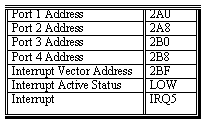APPENDIX D
MS-WINDOWS CONFIGURATION for version 3.x
The PCCOM 4 port device driver
for MS/WINDOWS works for 8250, 16450, 16550 (FIFO), 16650 etc. User can
set up any address to PCCOM 4 port card, and the address must be set to
consecutive.
D.1 Installation
| 1. |
You may set arbitrary I/O address and interrupts. However, we suggest you use the following: |

| 2. |
Insert the distribution diskette to floppy disk drive, then run PCCOMW.EXE. |
| 3. |
Select [Install]. |
| 4. |
Select the source path and the directory you want to install in it. |
| 5. |
When copy file is finish, enter to configuration window. |
| 6. |
Select your card type and the correct address/ IRQ value, then press [OK]. |
| 7. |
When the window presents 'complete', please restart Windows to let the driver work. |
D.2 Uninstall
| 1. |
Enter Windows to run PCCOMW.EXE by click on PCCOM icon. |
| 2. |
Select [Uninstall], and confirm that sure to uninstall. |
| 3. |
When the window shows 'Uninstall complete'', restart Windows to let old driver work. |
¡@
D.3 Utilities
| 1. |
Programming Manual |
Since window manager can
recognize only COM1 to COM9, however, to install PCCOM 4 port card, it
may occupy COM3 to COM10. In the distribution CD, we provide DLL
library and include file, all functions are similar to USER.EXE
functions.
Files:
COMMX.DLL (Dynamic linked library for aux COMs)
COMMX.LIB (Static library for aux COMs API)
COMMX.H (The include file for C/C++)
COMMX.DOC (Document)
COMMX.LIB (Static library for aux COMs API)
COMMX.H (The include file for C/C++)
COMMX.DOC (Document)
PCCOM library functions are similar to API Comm function
API functions
are ???COMM???()
PCCOM functions are ???COMMX???()
PCCOM functions are ???COMMX???()
For example, OpenComm() become OpenCommX() , parameters are the same.
 |
Following are the functions used with communications devices. |
int FAR PASCAL
_export BuildCommXDCB(LPCSTR, DCB FAR*);
int FAR PASCAL _export OpenCommX(LPSTR, UINT, UINT);
int FAR PASCAL _export CloseCommX(int);
int FAR PASCAL _export ReadCommX(int, LPSTR , int);
int FAR PASCAL _export WriteCommX(int,LPSTR , int);
int FAR PASCAL _export UngetCommXChar(int, char);
int FAR PASCAL _export FlushCommX(int, int);
int FAR PASCAL _export TransmitCommXChar(int, char);
int FAR PASCAL _export SetCommXState(const DCB FAR*);
int FAR PASCAL _export GetCommXState(int, DCB FAR*);
int FAR PASCAL _export GetCommXError(int, COMSTAT FAR* );
int FAR PASCAL _export SetCommXBreak(int);
int FAR PASCAL _export ClearCommXBreak(int);
UINT FAR* FAR PASCAL _export SetCommXEventMask(int, UINT);
UINT FAR PASCAL _export GetCommXEventMask(int, int);
LONG FAR PASCAL _export EscapeCommXFunction(int, int);
BOOL FAR PASCAL _export EnableCommXNotification(int, HWND, int, int);
int FAR PASCAL _export OpenCommX(LPSTR, UINT, UINT);
int FAR PASCAL _export CloseCommX(int);
int FAR PASCAL _export ReadCommX(int, LPSTR , int);
int FAR PASCAL _export WriteCommX(int,LPSTR , int);
int FAR PASCAL _export UngetCommXChar(int, char);
int FAR PASCAL _export FlushCommX(int, int);
int FAR PASCAL _export TransmitCommXChar(int, char);
int FAR PASCAL _export SetCommXState(const DCB FAR*);
int FAR PASCAL _export GetCommXState(int, DCB FAR*);
int FAR PASCAL _export GetCommXError(int, COMSTAT FAR* );
int FAR PASCAL _export SetCommXBreak(int);
int FAR PASCAL _export ClearCommXBreak(int);
UINT FAR* FAR PASCAL _export SetCommXEventMask(int, UINT);
UINT FAR PASCAL _export GetCommXEventMask(int, int);
LONG FAR PASCAL _export EscapeCommXFunction(int, int);
BOOL FAR PASCAL _export EnableCommXNotification(int, HWND, int, int);
| 2. |
Under standard WINDOW environment, to use "TERMINAL" and "CONTROL PANEL", only COM1 to COM4 can be used. If you need use COMx (more than COM4) with TERMINAL.EXE, please modify WIN.INI before enter to WINDOW. For example, to use COM6 with TERMINAL.EXE, please find |
[TERMINAL]
port=COMx
port=COMx
in
WIN.INI, then modify port=COMx to port=COM6.
| 3. |
No modification are necessary for applications using up to COM9, and the printers , modems may be connected up to COM9. |
| 4. |
SPECIAL NOTE : When you set 115200 baud( only with FIFOs ), please set 0xFF20 (or CBR_56000+1 ) to certain functions. |
¡@
D.4 Testing
| 1. |
Open two terminal applications under Windows. |
| 2. |
Open COM port for each terminal, and have the same configuration(baud, stop bit, protocol ...) e.g. |
| Open COM3 to one terminal (9600 baud, 1 stop bit, 8 data bit) | |
| Open COM4 to another terminal (9600 baud, 1 stop bit, 8 data bit) | |
| 3. |
Use 'NULL MODEM' method to connect the two ports. |
| 4. |
Try to transmit and receive data between the two terminal windows. |
